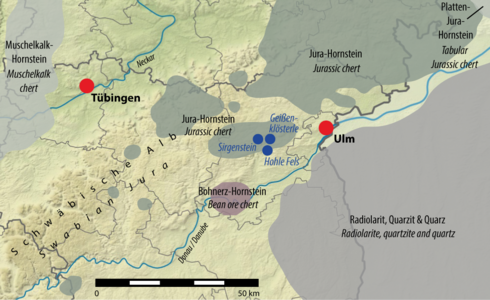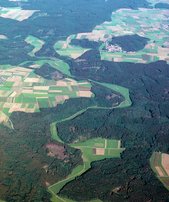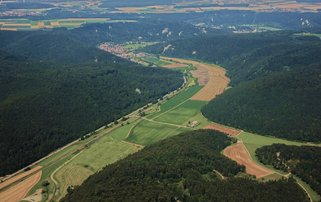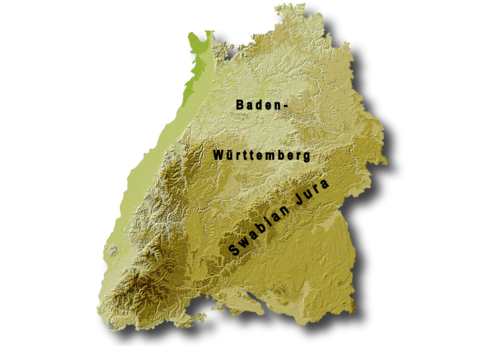Undisturbed landscapes
The World Heritage site "Caves and Ice Age Art in the Swabian Jura" is located in two valley sections of the Swabian Jura. The regional cluster of archaeological sites with remains from the Aurignacian is unique. It underpins the significance of the landscape for Ice Age people.
Even today the valleys of Ach and Lone are special, in large parts untouched places. Even though the landscape has changed in the course of millennia, the undisturbed views still enable us to imagine the land use of of Ice Age people. We can surmise how Palaeolithic hunter-gatherers wandered from cave to cave, hunting reindeer and horses.



A natural landscape with a long history
The Swabian Jura extends straight through southern Germany from the High Rhine in the southwest to the Nördlinger Ries in the northeast. As various European mountain ranges rose 60 million years ago – including the Alps – these uplands also formed. The various geological processes that impacted the Swabian Jura led to deposits of many different kinds of strata. The oldest of these extend back to the beginning of the Jura 200 million years ago. During the emergent millennia of the Earth’s history – between 20 million and 12 million years ago – the landscape was shaped primarily by the coming and going of ocean waters and volcanic activities. The span of time between about 12 and 2.6 million years ago was, conversely, shaped by weathering and erosion processes. At the same time, rivers such as the Danube, Ach and Lone dug deep into the stone so that the Swabian Jura formed the present configuration of a range of hills interspersed with valleys.

1) 1.8 million to 800,000 years ago. The Danube flows 80 m above today's valley floor.
2) 300,000 years ago. In some parts the Danube shifts its course.
3) 200,000 years ago. The Danube shifts its course to the present day Danube Valley.
4) 120,000 years ago. The two river systems of Schmiech as well as Ach and Blau flow in different directions through the old Danube Valley.

A cultural landscape as a unique archive

During the Ice Age the Swabian Jura was an untouched natural landscape, but already at this time hunter-gatherers made use of its natural resources.
In addition to the availability of prey, the region around the World Heritage site "Caves and Ice Age Art in the Swabian Jura" offered rich deposits of raw materials for the production of stone tools. People collected the different rock types and brought them into the caves for further processing. The origin of these rocks can be determined and shows us the use of the landscape by past people.
Camp sites of Palaeolithic hunter-gatherers must always be regarded in the context of regional land use. For archaeology, this means that in addition to the already known sites further potential and as yet undiscovered sites must also be considered. Therefore, not only the caves but also the surrounding landscape is part of this unique scientific archive of human (pre)history.






